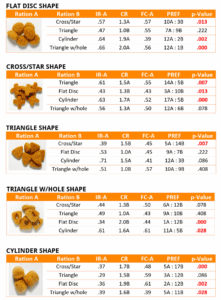OVERVIEW As pet owners increasingly seek tailored nutrition for their animals, understanding how life stages influence eating behavior becomes crucial. This work explores the link between two key palatability metrics, first choice and intake ratio, where in AFB palatability results it becomes clear that flavor preferences in pets evolve throughout...

Kibble Shape and its Effect on Feline Palatability
OVERVIEW
Creating a product that satisfies a cat’s preference can be challenging. As obligate carnivores,
cats seek out diets that contain higher amounts of protein, moderate amount of fat, and minimal carbohydrates. Drivers such as aroma, taste and temperature are important in determining if a cat will prefer a particular food. In addition, cats lack the lateral jaw movement required for grinding food. A cat’s teeth are made for shearing and tearing, thus making kibble texture and size another factor in determining which food cats find palatable.
Researchers at AFB International wanted to determine if kibble shape also affects the palatability of dry cat foods. These results can provide both operations and product implications for pet food manufacturers.
EXPERIMENTAL DESIGN
The study design looked at five different kibble shapes (Figure 1): flat disc, cross/star, triangle, triangle w/hole and cylinder. To control variability the same lot of a finely ground, grain-based meal was used for all shapes. All diets were coated with 5.0% poultry fat and 1.5% dry cat palatant.

All variables were within target specifications for moisture (6.5% – 9.5%), bulk density (19 – 24 lbs/ft3), diameter and thickness.
RESULTS
To measure palatability, feeding trials were completed at the company’s Palatability Assessment Resource Center (PARC) with the same panel of 25 cats. Paired preference trials were conducted with two exposures (25 cats x 2 days) and bowl placement was alternated each day. All possible shape combinations of paired tests were completed.
Palatability data looked at consumption ratio (CR), intake ratio (IR), first choice (FC) preference and p-Value.

CONCLUSIONS
Kibble shape does affect the palatability of dry cat foods. Overall, the flat disc and cross/star shapes had the best palatability scores. In a paired comparison between flat disc and cross/star, the flat disc shape was preferred.
The preference for the flat disc shape can be advantageous for pet food manufacturers. The flat disc shape is easier to extrude, less potential for die blockage, less drag, higher throughput, and lower tooling costs. The flat disc shape also has more surface area which can assist with palatant adherence and palatability.